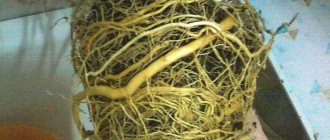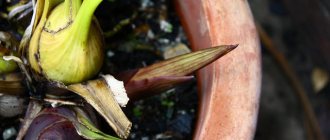- September 13, 2019
- Houseplants
- Svetlana Pavlova
Dracaena is a popular plant among indoor flower lovers. It does not require complex care, pleases with beautiful greenery and grows quickly. With rapid development, the flower often loses its decorative effect, the trunk becomes greatly elongated, it becomes exposed, and the leaves remain only at the top. But it’s easy for him to regain his former attractiveness. In this article we will look at how to plant dracaena at home using different methods.
General characteristics of the plant
Dracaena belongs to the Asparagus family. The plant is a succulent shrub native to South America. The local population is convinced that a dracaena branch, which is cut at midnight during the full moon, brings good luck in love affairs. Ten species are used for growing in apartments. They grow quickly and it is often necessary to plant dracaena at home.
The plant is sometimes called false palm. It has long and narrow leaves, the ends of which are curved down. The trunks of young dracaenas are flexible. For the composition, several plants are planted in a pot, intertwining them with each other.
Features of transplantation
Dracaena can be grown at home for decades. With the constant development of the root system, the container becomes cramped over time. The appearance of the flower deteriorates due to lack of nutrients and requires replanting. How to plant dracaena at home? This event requires compliance with the following rules:
- The diameter of the new container should be 2.5 cm larger in diameter than the previous one. It is better to take a container that is not wide, so that new roots do not actively form, but the vegetative mass increases.
- The plant will require loose, nutritious soil. To prepare soil at home, take turf soil, humus, peat and sand in equal proportions. It is first calcined in the oven.
- Drainage must be placed at the bottom of the container.
- When transferring into a new container, carefully inspect the root system, removing damaged shoots.
- The substrate near the trunk is compacted and moderate watering is done.
Young plants require annual replanting, and adults - as the root system increases.
Self-pruning dracaena - how to do it right
Pruning in itself is stressful for the plant, and if it is done during a period of pronounced dormancy from October to January inclusive, it is doubly painful. The plant is weakened, the healing of cuts and the appearance of side shoots occurs much more slowly, and even the death of the plant is possible during the rehabilitation period. Nevertheless, pruning must be carried out, but the best time for this operation is the period from early spring to early autumn, during the growth phase, when the cut sites heal better and faster and dormant buds awaken.
In order not to further injure the plant, pruning must be carried out on time and correctly.
There are several reasons for pruning dracaena:
- aging of the plant, the need for rejuvenation;
- deformation of dracaena, the need to give the crown shape;
- propagation of dracaena by transplanting shoots;
- disease prevention, pest treatment.
You can learn more about how to deal with diseases and pests of dracaena from the material:
Pruning to produce side shoots
If you purchased a young plant with one trunk, and it is of sufficient length - at least 30 cm to the point where the leaves form - it can be pruned for branching. To do this, 10 cm is cut from the top of the dracaena. After the procedure, two to five new shoots may form on the trunk. It is customary to leave three strong shoots so that they are freely located on the stem.
Dracaena marginata: before and after pruning to obtain side shoots
Pruning for branching
It is carried out in cases where the leaves of the dracaena fall off and it is necessary to return its lush and elegant crown. If there are 2-3 branches on the trunk, cut off the tops of each of them at the same height, leaving only 2-3 hatched dormant buds.
It is recommended to leave 2-3 hatched buds after pruning
If you trim the shoots at different heights, you can get a beautiful multi-tiered plant.
A multi-tiered dracaena is created by trimming the tops at different heights
How to make a dracaena bonsai
Growing dracaena using the bonsai technique is possible in principle, but is associated with great difficulties. Dracaena grows quickly, and some of its species have large leaves, so it will not make a real dwarf tree - although you can try to imitate the Japanese technique.
You can achieve the desired result if you ensure uniform development of the root system and foliage.
Recent Entries
Lilac perennials that are beautiful, compact and do not crowd out other plants Why when buying seedlings you should not take the sellers’ word for it and how to determine the age of the plant using 3 signs Tomato seedlings have turned purple or whitish: why the color has changed and how to save the plants
You need to take a plant with a short trunk (no higher than 30 cm) and a developed crown, remove it from the pot and trim the roots by about a third. Transplant the plant into a suitable flat container with drainage. The root collar remains 1–2 cm above the soil level. After 2–3 weeks, you can begin to form the crown. Trimming the top and side shoots are further operations that are performed according to growth and the desired result. The roots are pruned once every two years. To create additional shoots, the so-called tops, lignified shoots are cut off near the trunk. This procedure helps thicken the trunk below the cut branches. Excess shoots are removed from the trunk.
After pruning, several tops formed at the root neck of the dracaena
After transplanting the dracaena, pruning is carried out at the discretion of the owner - depending on the shape you want to get. So, for example, you can lift the root collar, leave one strong sprout in place of the cut top, and remove the rest.
After pruning dracaena, you can leave only one strong sprout
Dracaena bonsai is quite demanding in care. It is necessary to regularly and thoroughly wipe dust from the leaves, remove yellow leaves in a timely manner, monitor the level of humidity in the room: frequently spray the plant, use a double tray with wet gravel, plant moss in the soil where the dracaena grows - it retains moisture.
2 times a week, the dracaena needs to be turned 90 degrees towards the light to ensure even distribution of sunlight.
Rejuvenation of dracaena using pruning
As the plant ages, the lower leaves dry out and fall off, and the trunk becomes long and unattractive. As necessary, pruning is done to renew the plant. The long trunk is shortened - the minimum recommended height is not lower than 5 cm, although you can trim the dracaena almost to the base, leaving at most three buds at a height of 0.5 cm. Just make sure that the cut is always open until healing. The area below the cut level is treated with a growth stimulator and wrapped with moss. After such pruning, the awakened buds will begin to grow, no longer in the side shoots, but in the central trunks.
The dracaena received such a magnificent outfit after anti-aging pruning
You cannot prune a diseased plant that can be treated for rejuvenating purposes. Usually, after pruning an unhealthy dracaena, rotting of the cut areas begins and the trunk is affected to the very base - then it is almost impossible to save it. You need to try to cure it first, and then start pruning. After pruning, a healthy dracaena will begin to branch and regain its former beauty.
Sanitary pruning
In case of severe disease of dracaena, pruning is done at any time of the year. Cut off all affected parts of the plant: sections of the trunk, branches, leaves. Be sure to check the condition of the root system - if the roots are partially rotted, the affected areas are also pruned and disinfected. If the root system is completely rotted, you can try to save healthy parts of the dracaena for reproduction. Cut tops and parts of the trunk that are not infected and will subsequently be replanted are soaked in a weak solution of potassium permanganate for 6 hours for prevention.
In the absence of disease, if, for example, dracaena shoots are deformed, sanitary-forming pruning is carried out with the removal of all tops, deformed shoots and dried leaves.
Planting dracaena
Often young plants in a flower shop sell several copies in one container. As they grow, each of them is transplanted into a separate container. This procedure is best carried out in the spring. Before transplanting, it is necessary to prepare the correct substrate. Ready-made mixtures for palms and cacti are well suited for dracaenas. How to plant dracaena at home, a photo of which is presented in the article? For this:
- Before replanting, moisten the soil abundantly;
- remove the group planting from the container without destroying the earthen ball;
- carefully, without damaging the roots, disassemble a group of plants into individual specimens;
- fill the pots with soil, first placing drainage on the bottom;
- Compact the substrate around the plant and water with warm, settled water.
Place the transplanted flowers in a bright place, avoid direct sunlight.
How to update dracaena?
The houseplant can grow very tall. But due to lack of light and volume of the pot, the leaves begin to fade, the shoots become thin and small. In addition, in mature dracaenas the lower part of the trunk becomes bare. In this case, they resort to flower rejuvenation. How to breed dracaena? There are several ways to get offspring from dracaena. In an apartment or office, the plant is propagated:
- Apical cuttings - used for very elongated plants. Shortening the top promotes the development of lateral shoots.
- Stem cuttings - unsuccessfully grown shoots are removed and cuttings are cut from them, this makes the dracaena tidier.
- Air layering is a longer method than the first two. Three cuttings are obtained from one plant, and they take root quickly.
- Seeds are the most difficult way. It is very difficult to obtain seeds at home; dracaena blooms in captivity in exceptional cases. But, if you purchased successful seeds, it is possible to get many young plants at once.
To grow a new flower, everyone chooses the most suitable method on their own.
General characteristics of dracaena
A houseplant that resembles a spreading palm tree can be found in many apartments. With proper care, the lush crown gives the flower a perky, attractive appearance.
Growing up, dracaena, the propagation of which is most often carried out by cuttings of shoots, provides material for planting. In addition, elongated stems lose their aesthetics and require corrective pruning. Having figured out how to plant dracaena after cuttings, you can get several young plants.
Breeding Tips
The most favorable period for propagation of the dracaena palm is considered to be the beginning of April, when the plant begins active growth after the winter period. At this time, the rooting process is especially fast. If you omitted this point, then young plants can be grown at any other time, but reproduction will not take place so quickly. The winter period is no exception. The only thing you need to remember is to turn on artificial lighting and it is advisable to add additional heating.
Reproduction by apical cuttings: algorithm of actions
How to plant dracaena at home using cuttings? This method of breeding is often called crown propagation. The plant must be developed and have a leafy crown. The process is quite simple and convenient. To do this, you should adhere to the following algorithm:
- Cut off the top with a sharp knife, previously heated over fire or wiped with alcohol.
- Treat the cuttings with Kornevin.
- Place in water for rooting or in damp sand.
- How to propagate dracaena from an old plant? To get new tops on the mother plant, leave a stump of about 6 cm. Sprinkle the cut with activated carbon and cover with a bottle. Ventilate and water occasionally; over time, a new plant with several tops will appear.
The cutting for rooting must be without damage to the bark and free from stains and cracks.
Rooting of the top will go faster if:
- Change the water every two to three days to prevent rotting.
- Dissolve an activated carbon tablet in water for disinfection.
- When rooting in sand, the soil needs to be slightly moistened.
- Keep the container with the plant in a bright place, without direct sunlight.
- Make a greenhouse for the plant from transparent material and ventilate it daily.
- It is advisable to spray the leaves with a palm fertilizer solution.
Following the recommendations, an adult plant grows from the top very quickly.
How to root dracaena at home
The cuttings can be placed in water, placed in a common container for germination, or the dracaena can be planted in individual cups. If the reproduction of fragments occurs in a vertical position, it is important not to confuse the top and bottom.
In water
It is better to take the container from dark glass, but the culture can be propagated in plastic or transparent containers. The size of the vessel should be such that the piece of stem used for propagation does not fall. If there are leaves, you need to “hang” the stalk on them, or make sure that the lower part does not touch the bottom of the dish:
- place a thick sheet of paper on top;
- punch a hole in the center;
- insert the shoot.
Unlike ficuses, the water in the container with dracaena will not have to be added, but changed 1-2 times a week - as soon as the liquid becomes cloudy. It is useful to put an activated carbon tablet at the bottom.
When the hatched roots reach a size of 2-5 cm, the dracaena is planted in a small glass and light soil. Too long shoots are likely to break when moving into the substrate.
How to plant dracaena without roots
Planting dracaena when propagated by pieces of the trunk is possible in two ways:
- vertical;
- horizontally.
The first method is more common and is suitable for propagation by the tip or stem fragments of any size.
For rooting, use light soil, peat-sand mixture or a permeable, porous, chemically neutral substrate:
- perlite;
- fine expanded clay;
- clean coarse sand.
Plant vertically or at a slight slope:
- Stick it into the ground so as to give the cuttings stability. The longer it is, the more it will need to be buried.
- Knead and wet the substrate.
- To speed up rooting, place it in a greenhouse and cover it with a jar or transparent cellophane.
- Maintain a temperature of about 25° C.
- Ventilate daily, spray the stem and leaves as soon as the condensation on the shelter disappears.
You can place several shoots in one pot, and after 1.5-2 months, when rooting occurs, plant them.
To propagate trunk fragments in a horizontal position, you need:
- Take a wide, low pot.
- Fill halfway with drainage, pour rooting substrate on top.
- Place the cutting prepared for propagation on the soil and press it lightly, no more than halfway.
- Sprout and care as described above.
- Offspring will appear from several nodes. When they grow up, remove them from the substrate and divide them into parts so that each contains a rosette of leaves.
- Plant in individual pots.
Propagation by stem cuttings
How to plant dracaena at home? In some situations, for some reason the plant looks very bad and dies, but there are still parts of the stems that are suitable for growing a new flower. In this case, it is quite appropriate to apply the method of propagating dracaena using stem cuttings. To do this, select that part of the stem that does not contain cracks or surface damage, and cut cuttings about five centimeters in size. It is better to make a cut in the places where the leaves are attached. Each cutting must contain at least two buds. Rooting is carried out in sand in two ways:
- Vertical - cuttings are planted vertically, one end is buried three centimeters in the sand.
- Horizontal - chopped stems are laid horizontally on the substrate and pressed a little, without deepening completely. In this case, two or more new dracaenas appear.
With such rooting, the soil, consisting of sand, is always kept moist. The optimal air temperature in the apartment is twenty-five degrees. Roots begin to appear after two months.
Trimming time
The dracaena stem is a structure in which dormant buds are arranged in a spiral along its entire length. This is what makes it possible to obtain seedlings and the beginnings of new branches from a cut made in any part of the trunk.
Planned pruning of dracaena is done during the active growth period, when sap flow is best. There are times when the formation of a bush is needed urgently. For example, part of the stem broke off. Then the shortening must be carried out according to the rules, below the break point. Any pruning can only be effective on a healthy plant.
Caring for cuttings
How to plant dracaena correctly? When rooting cuttings, it is necessary to monitor their development. The first sign that they have roots is the beginning of their growth. In the apical leaves, new leaves grow, and in the stem leaves, the buds swell, from which young shoots appear. With confident growth of the cuttings, the time they spend in the open air is gradually increased, i.e., without the film, and then it is removed completely. We should not forget about the humidity of the air in the room and the substrate in the container. Rooted cuttings will require bright lighting, but without direct sunlight. For cuttings that germinate in water, the water is changed after two to three days.
Reproduction by air layering
This method is ideal for obtaining young plants if the dracaena has grown very tall. It is recommended for use by experienced flower growers. Let's look at how to plant dracaena at home step by step, using layering:
- Prepare nylon thread, sphagnum moss and a plastic bag in advance.
- Determined by the height of the seedling.
- The required distance is measured from the top, the plant is cleared of leaves and a small cut is made under the leaf scar, with a depth to the middle of the trunk.
- A wooden or plastic object is inserted into the incision: a match, a toothpick or a small plate so that it does not become overgrown.
- Wet moss is wrapped around the trunk, covered with a bag and tied.
- Make sure the moss is always damp.
- When the roots have grown strongly, the bag is removed, the shoot is separated from the mother tree and transplanted into a small pot.
- Make a small greenhouse by covering the flower with a glass container. After a few days it can be removed.
Air layering with roots takes root very quickly.
Propagation by seeds
In very rare cases, dracaena blooms indoors and it is even possible to collect the seeds. But it should be borne in mind that they rarely ripen and have poor germination. How to plant dracaena at home using seeds? It is best to purchase planting material from a flower shop so that the seeds have good germination. In this case, it is easier to grow a varietal plant. They are sown early - in late February or early March. The soil is prepared for the substrate by mixing equal proportions of sand and turf soil. To grow you need:
- soak the seeds in a solution of a growth stimulator;
- plant in the ground at a distance of 5 cm from each other;
- Cover the top of the container with film;
- after germination, feed the soil and constantly moisten the soil;
- plant the plants in separate pots when they reach five centimeters.
This method of growing dracaena takes from two to three months.
Features of rooting cuttings
You can root the apical cuttings of dracaena in different ways.
As practice shows, rooting in water gives the best results, but planting a cutting in the ground can also end positively, especially if you study all the features of the process in advance.
The first rule is to use only healthy tree tops for planting, without damage or stripped bark.
a sharp knife for cutting , pre-treated with alcohol or disinfected with another preparation. It is recommended to make the cut at a slight angle.
The top should be rooted immediately - there is no need to wait until the cut area dries out a little. The recommended cutting length is no more than 15 cm ; longer shoots take root poorly and will require support.
Before planting the cutting, you can treat the cut with any root growth stimulator (most often Kornevin is used). Good results are obtained by short (no more than a quarter of an hour) soaking in the solution. Only after this can you start planting the cuttings.
Seedling care
How to plant dracaena at home? Seedlings grown from dracaena seeds require careful care. It is very susceptible to watering; the soil must be constantly moist. Its drying out causes the death of young plants. And waterlogged soil leads to fungal diseases and root rotting. In addition, tropical plants need humidified air. Seedlings require constant spraying. In this case, it is necessary to ensure that water does not get into the axils of the leaves, otherwise they will rot. Next to the containers, it is best to place containers filled with water and pebbles, which will gradually evaporate and increase the humidity in the room. It is advisable to place plants on eastern windows.
Possible problems when propagating dracaenas
Despite the fact that dracaena is a very unpretentious indoor flower, even experienced gardeners make some typical mistakes that lead to the death of the plant. The most common are:
- Excessive watering - you should not over-water the soil ball, nor should you over-dry it. Young plants are very sensitive to excess moisture; the roots can rot and they will die.
- Using used containers for transplanting and rooting contributes to the spread of infection. When propagating dracaenas, try to use only new pots.
- Keeping a flower under a film for a long time requires constant ventilation and weaning of the plant from the greenhouse.
Compliance with all rules leads to successful reproduction.
Features of care after pruning
After pruning, the dracaena is watered 2-3 times a week through a tray, since in order to maintain a stable microclimate and until new seedlings appear, the bag is not removed. The stem is sprayed with water at room temperature 3-4 times a week. Once a week, the moss, if any, is moistened and the trunk is inspected. Immediately after the buds have hatched on the trunk, the cellophane is removed and the pot is transferred to the light.
Material on methods of propagating dracaena will also be useful:











